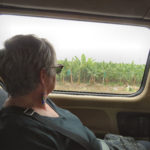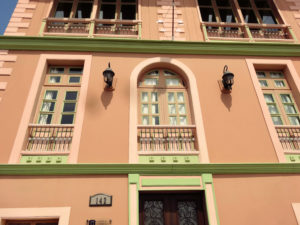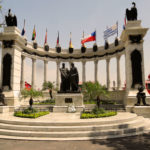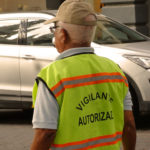Guayaquil was a nice change. Luxurious sheets, well appointed room, Sangria brought from the bar and something besides Animal Planet on TV. We met a nice couple bicycling around the world who were staying in the hotel while she recovered from an accident and another couple at breakfast who were astounded that we had traveled on a bus. So the level of adventure does vary from traveler to traveler. We hired a driver to bring us back to Cuenca and I am not so sure we were any better off than on the bus, but the ride was beautiful if a bit scary. Leaving Guayaquil we were struck by the stark poverty that we saw in contrast to the natural beauty of the landscape. Dirty little towns and shacks sat along the road with open air restaurants were full of local resi ents eating lunch and drinking coffee. Their houses are little shacks on stilts each with one opening for a door and no windows. Some have new tin on the roof, but most the them have a rusty roof that would do little to protect the homeowner. A few scrawny chickens peck in the muddy dirt hunting for insects or worms. The people have no garden space to supplement their obviously poor diet. However, their native artistic sense is evident in their fruit stands. Mangoes, bananas, papaya, and watermelon are beautifully arranged on carts in a manner that best shows off the color and shape of the fruit. They are selling cut melons that were artful. We are always impressed by their merchandizing ability. They do not seem unhappy with their lives. They swim in the river have picnics by the water and play like children. Maybe the simple life suits them or they simply do not know any other way to live. The huge agribusiness fields are well tended and stretch as far as the eye can see while the smaller plots are worked by hand. I am sure many of the folks work for the agribusinesses when it is time to pick the crops. Small trucks loaded with bananas head west to Guayaquil to be sold to markets. We leave the flat lands and head up the mountain.
This is where the trip gets scary. The road is slick and curvy and we are soon in the clouds. The driver does not slow down. Troy tries to sleep so he can ignore this Mr. Toad’s Wild Ride. He does not sleep and I do not try. I think Manuelo believes that PILEGRO ZONA DERRUMBLES means drive like hell and no passing really meant TAKE OFF WHAT DO YOU HAVE TO LOSE. Honk the horn and everybody must get out of the way. WE stop for lunch which was chicken soup with a wing and a boiled egg in it which we bolt down and hit the road again. The scenery is gorgeous. Huge philodendron, ferns, lichen grow out of the mountain which constantly nourishes them with water and minerals. Lack of sun light means there are no flowers except for an occasional lupine. There is no sign of human activity until many miles later and then we sight small hotels, fishing camps and some ranching activity. This area is much more prosperous. There are garden plots, roses and Shasta daisies growing in the yard, children wear school uniforms and play alongside the road. Much of this area is CAJA NATIONAL PARK and the residents benefit from the park visitors. Soon Cuenca appears. This beautiful little jewel of a city nestles in the valley of four rivers. The Old Cathedral and the New Cathedral wait patiently for us. The maid did not come to the apartment as we wished but it doesn’t really matter.
Adios,
Sally




 Guayaquil is a tropical city and very different from Quito and Cuenca. We spent the morning in some very typical Texas weather. We visited Las Penas on the north end of the Malecon which represents the old Guayaquil. That area has been destroyed by fire, flood and faced an epidemic that killed thousands of its citizens. Las Penas is now an artist colony, boutique shopping area and a Bohemian settlement with some of the old wooden houses. They are built into the side of a hill almost on top of each other. They are pastel,and shuttered with interesting open design panesl to let in air. Some of the most famous Ecuadorian citizens had homes there. A fort protected Las Penas from invaders. I loved the interesting houses and the attempt to use them today.
Guayaquil is a tropical city and very different from Quito and Cuenca. We spent the morning in some very typical Texas weather. We visited Las Penas on the north end of the Malecon which represents the old Guayaquil. That area has been destroyed by fire, flood and faced an epidemic that killed thousands of its citizens. Las Penas is now an artist colony, boutique shopping area and a Bohemian settlement with some of the old wooden houses. They are built into the side of a hill almost on top of each other. They are pastel,and shuttered with interesting open design panesl to let in air. Some of the most famous Ecuadorian citizens had homes there. A fort protected Las Penas from invaders. I loved the interesting houses and the attempt to use them today.



